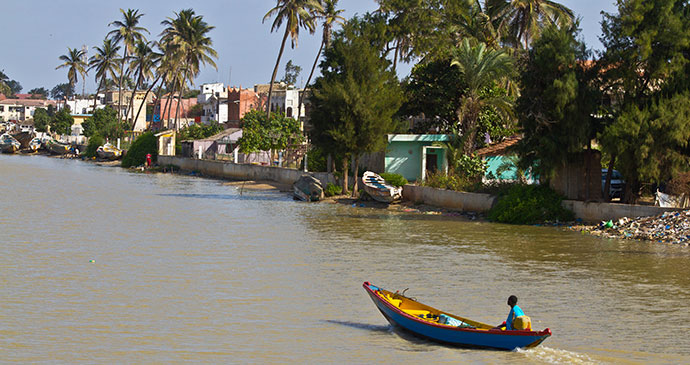 The tiny city-island of Saint-Louis is lapped on either side by the waters of the Senegal River © Antpun, Dreamstime
The tiny city-island of Saint-Louis is lapped on either side by the waters of the Senegal River © Antpun, Dreamstime
History feels close enough to touch in Saint-Louis, its architecture steeped in 19th-century grandeur.
Dripping with balconies and bougainvillea, the stately ochre homes and warehouses of old Saint-Louis, with their toothless wooden shutters and Marseillaise clay roof tiles, are the steadfast and picturesque guardians of one of the most intensely atmospheric and densely historied places in all of West Africa. Known as Ndar in Wolof, the tiny city-island sits protected by the Langue de Barbarie peninsula to the west and lapped on either side by the calm waters of the Senegal River as they make their final approach to the Atlantic.
As the crossroads of Senegal’s north, Saint-Louis has a population as diverse as its history, and the island’s grid of sandblown streets are home to Wolof merchants in perfectly starched boubous and Moroccan babouche slippers, Mauritanian shopkeepers forever adjusting their impossibly large blue robes, scarified Toucouleurs proudly sporting their beauty marks, Baye Fall devotees piled high with leather gris-gris, and the island’s indigènes, the mixed-race descendants of the Métis signares, who can occasionally be spotted in their traditional flowing white gowns.
The orderly streets here radiate history, and perhaps never more visibly than in the early evening, when the thick clay walls of the city glow with the accumulated heat of the day, insulating against the cool ocean winds that whip in from the west. Doors are flung open, televisions switched on, and residents hiding from the afternoon sun once again dare to come out on to the streets and take their evening promenade, making the rounds from family to family, tending friendships that trace their roots not only to childhood, but sometimes two, three and even more generations back amongst the old families of the island. Listen out for drums – it’s not uncommon for a family to simply close off one of the back streets in front of their home to celebrate a wedding or other event with an impromptu street party and a sabar band. Saint-Louis is in many ways the feather in Senegal’s cap, and a startlingly lucid window into the long and difficult history of this rapidly modernising country, where traces of the past can and do disappear by the day. Any visitor who doesn’t make the trip up here is missing out not only on one of Senegal’s most fascinating destinations, but on a chance to physically and intellectually engage with the places and events that have shaped the Senegal of today.